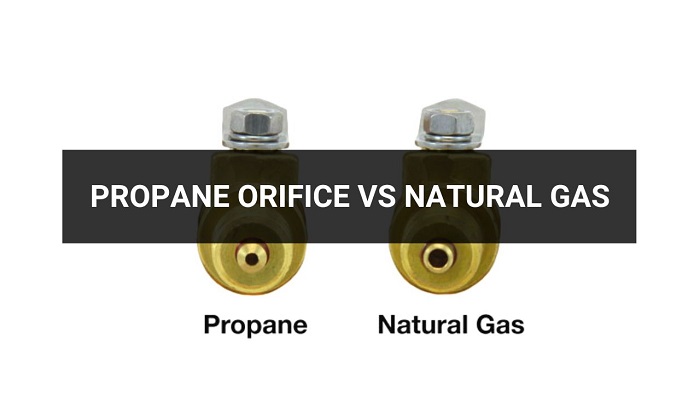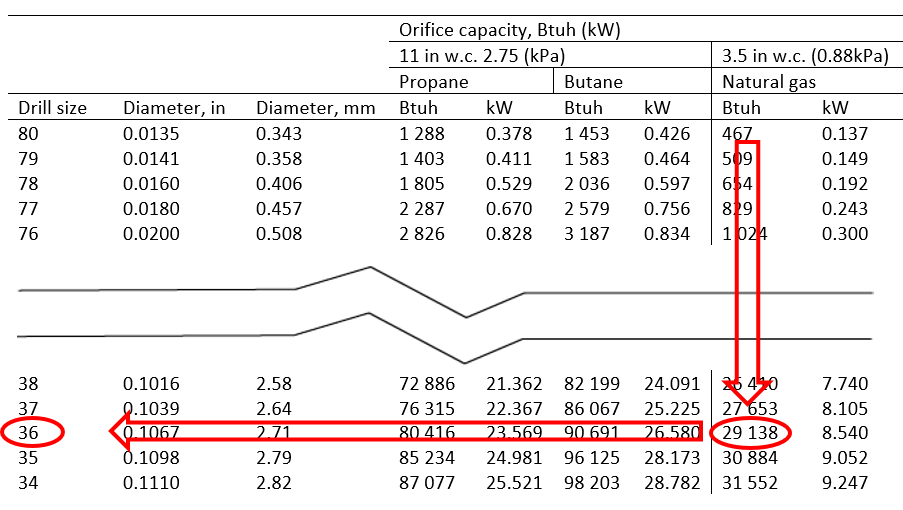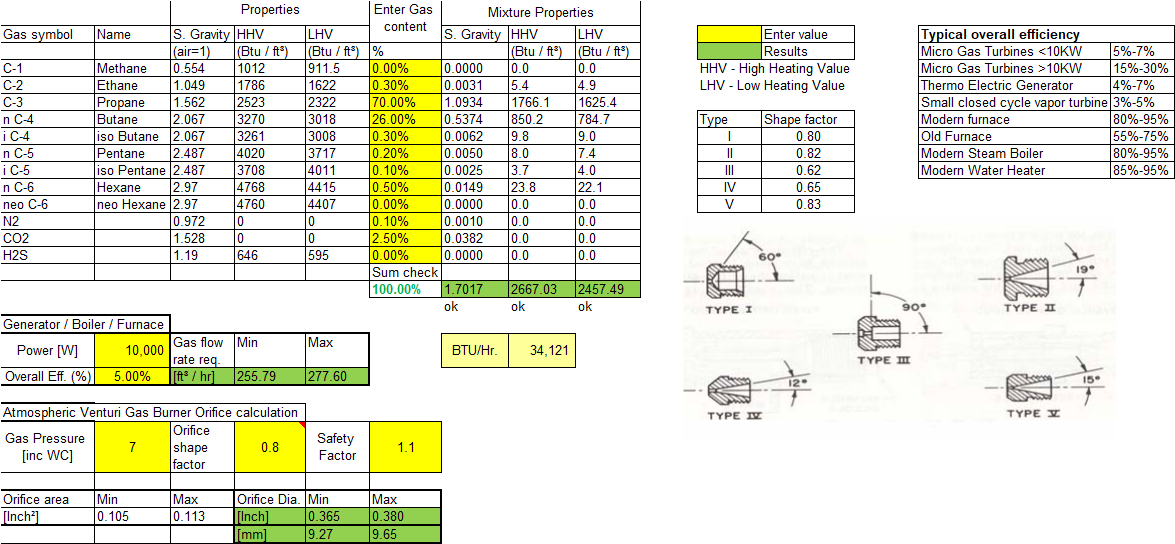Natural Gas Vs Lp Orifice Size

When it comes to using gas appliances in your home, understanding the difference between natural gas and liquefied petroleum (LP) gas, and specifically the orifice sizes required for each, is crucial for safe and efficient operation. Incorrect orifice sizing can lead to dangerous situations like gas leaks, carbon monoxide poisoning, or appliance malfunction. This guide aims to demystify the topic, explaining the key concepts in a straightforward manner to help you make informed decisions.
Understanding Natural Gas and LP Gas
First, let's define what natural gas and LP gas are, and how they differ:
- Natural Gas (NG): Primarily composed of methane, natural gas is typically sourced from underground deposits. It's lighter than air, which means that if a leak occurs, it tends to dissipate upwards.
- Liquefied Petroleum (LP) Gas (Propane): A mixture of propane and butane, LP gas is stored under pressure as a liquid. When released, it vaporizes into a gas. LP gas is heavier than air, so leaks can accumulate near the ground.
The key difference for our discussion lies in their energy content or heating value. Natural gas has a lower heating value per unit volume compared to LP gas. This means that LP gas contains more energy per cubic foot (or other unit of volume) than natural gas.
The Role of Orifices in Gas Appliances
Think of an orifice as a carefully sized hole or jet that controls the amount of gas flowing into the burner of an appliance. Gas appliances, like stoves, water heaters, and furnaces, need a precise air-to-gas mixture for proper combustion. The orifice is a critical component in achieving this mixture.
The orifice size directly impacts the gas flow rate. A larger orifice allows more gas to flow through, while a smaller orifice restricts the flow.
Why Orifice Size Matters
Because natural gas and LP gas have different heating values, they require different orifice sizes to deliver the appropriate amount of energy to the burner.
- Natural Gas Appliances: Designed to use a larger volume of gas (because it has less energy per volume), these appliances typically have larger orifices.
- LP Gas Appliances: Because LP gas packs more energy per volume, these appliances use a smaller volume of gas, requiring smaller orifices.
Using the wrong orifice size can have serious consequences:
- Using a natural gas orifice on an LP gas appliance: This will result in a dangerously high gas flow rate. The appliance will produce a very large, yellow, and sooty flame. This is inefficient, wastes fuel, and produces excessive carbon monoxide, a deadly gas. It can also damage the appliance.
- Using an LP gas orifice on a natural gas appliance: This will result in a low gas flow rate, producing a weak, unstable flame. The appliance might not heat properly or may not even function.
In short, the orifice is a flow restrictor, and if the flow is incorrect, your appliance won't work safely or efficiently.
Determining the Correct Orifice Size
The correct orifice size for your appliance is absolutely crucial and should never be guessed. Here's how to determine it:
- Check the Appliance's Nameplate: The appliance's nameplate or label should specify the type of gas it's designed for (natural gas or LP gas) and the correct orifice size. The orifice size is typically expressed as a number, which corresponds to a specific drill size.
- Consult the Appliance's Manual: The user manual or installation instructions will provide detailed information on orifice sizes and any necessary conversions.
- Contact the Manufacturer: If you're unsure, contact the appliance manufacturer directly. They can provide the most accurate information for your specific model.
- Hire a Qualified Technician: If you're not comfortable working with gas appliances, hire a qualified gas technician. They have the knowledge and tools to properly identify and install the correct orifice.
Important Note: Never drill or modify an orifice yourself. Orifice sizes are very precise, and any alteration can compromise the safety and performance of the appliance.
Orifice Size Charts and Conversion
Sometimes, you might need to convert an appliance from natural gas to LP gas, or vice versa. This requires replacing the orifices with the correct size for the new fuel type.
Orifice size charts are available online and in appliance repair manuals. These charts list the appropriate orifice size (drill size number) for different BTU (British Thermal Unit) input ratings and gas types.
Example: Let's say your appliance is currently set up for natural gas and has a BTU rating of 40,000 BTU/hr. According to the chart, it uses a #50 drill size orifice. If you want to convert it to LP gas, you would need to consult the chart again to find the LP gas orifice size for a 40,000 BTU/hr appliance. This might be a smaller orifice, like a #55 or #60 drill size.
Caution: Always double-check the chart and verify the orifice size with the manufacturer or a qualified technician before making any changes.
Converting Appliances Between Natural Gas and LP Gas
Converting an appliance between natural gas and LP gas isn't just about changing the orifice. It often involves other adjustments to ensure proper operation.
Here are some common steps involved in the conversion process:
- Orifice Replacement: As discussed, this is the most critical step. Replace the existing orifices with the correct size for the new fuel type.
- Pressure Regulator Adjustment: Gas appliances use pressure regulators to maintain a consistent gas pressure. Natural gas and LP gas often require different pressure settings. The pressure regulator needs to be adjusted to the correct setting for the new fuel. This adjustment is usually made using a screw or adjustment knob on the regulator.
- Burner Adjustment: The burner might need to be adjusted to achieve the optimal air-to-gas mixture. This involves adjusting the air shutters or other air intake mechanisms on the burner.
- Pilot Light Adjustment (if applicable): Some appliances have a pilot light. The pilot light orifice might also need to be changed or adjusted for the new fuel type.
Warning: Converting an appliance from one gas type to another is a complex procedure and should only be performed by a qualified gas technician. Incorrect conversion can lead to serious safety hazards.
Safety Considerations
Working with gas appliances always carries a risk. Here are some important safety precautions to keep in mind:
- Always turn off the gas supply before working on any gas appliance.
- Never smoke or use open flames near gas appliances.
- Use the correct tools for the job.
- Check for gas leaks after making any changes. Use a gas leak detector or a soapy water solution to check connections for bubbles.
- If you smell gas, evacuate the area immediately and call your gas company or fire department.
- Install carbon monoxide detectors in your home. Carbon monoxide is a colorless, odorless, and deadly gas.
- Regularly inspect your gas appliances for signs of damage or wear.
Summary: Key Takeaways
Here's a quick recap of the important points to remember:
- Natural gas and LP gas have different heating values, requiring different orifice sizes.
- Using the wrong orifice size can be dangerous and lead to appliance malfunction.
- The correct orifice size is usually specified on the appliance's nameplate or in the manual.
- Converting an appliance from one gas type to another is a complex procedure that should only be performed by a qualified technician.
- Always prioritize safety when working with gas appliances.
By understanding the importance of orifice sizes and taking the necessary precautions, you can ensure that your gas appliances operate safely and efficiently for years to come.
When in doubt, always consult a qualified gas technician. Your safety and the proper functioning of your appliances are worth the investment.










